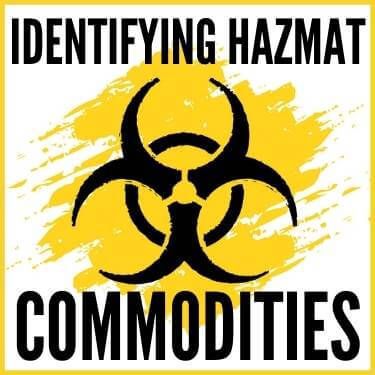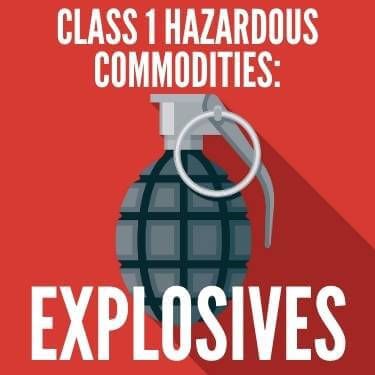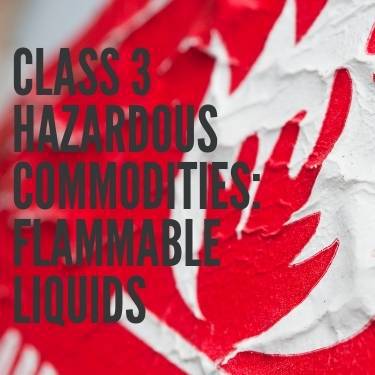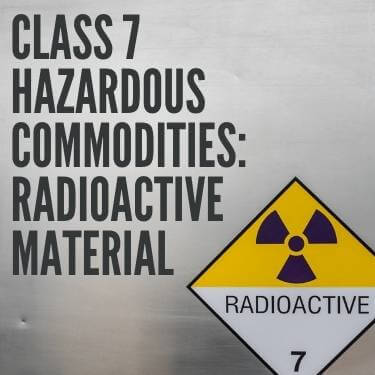If you’re about to ship HAZMAT commodities and have never done it before, it’s time to pump the brakes. It’s not simply enough to say you need to know more about these types of goods — it can be a matter of serious injury or even death if HAZMAT items are not shipped correctly. This means you need to do some research on the kinds of products you’re planning on having freight shipped.
Yet, we’re not talking about brain surgery when trying to make sense of HAZMAT commodities. You just need to understand the different classifications of the items you’re having shipped fall into and what is able to be shipped with what. Certain HAZMAT items can’t be placed together because of undesirable reactions.

In regard to this article, hazmat in this case is also referred to as dangerous goods. These are substances or materials that can threaten the environment or the health of humans and other living organisms. When the goods are not en route to a destination, they are simply known as hazardous materials.
In the U.S., while these dangerous goods are being transported, there are diamond-shaped markings on either the item itself or the container it’s being shipped in that have markings which indicate what class the commodity is in (classes are explained in further detail below). For example, there are symbols within the diamond that denote what kind of commodity, such as the classic skull and crossbones to signify that the substance is poisonous. Even the color of the diamond itself has significance — a diamond with a red outline denotes the substance is flammable while an orange outside marks explosives.

This kind of commodity comprises a very small amount of total trucking shipments but — due to their very nature — have to be handled with the utmost care. These are items that are designed to detonate either through a device or a chemical reaction and explode.
To give examples of what is included in this category of HAZMAT, it’s important to look at the six separate divisions and what they particularly cover. This class has the most divisions and you’ll soon see why.
These are items such as dynamite, TNT, ammonium nitrate/fuel oil (ANFO), torpedoes, black powder, nitroglycerine and mercury fulminate.
This can be certain types of fireworks, hand grenades, some kinds of ammunition and detonation fuses. These items have a risk of being a projection hazard but will not pose a mass explosion risk.
These commodities can pose a fire hazard and even have a small blast or projection hazard but are not risks for a mass explosion. Commercial fireworks, sodium picramate, rocket propellant and motors, and other liquid or solid propellants are all examples of goods posing a minor blast risk.
Small arms ammunition, consumer fireworks, empty primed grenades, toy caps, model rocket motors and railway fog signals are all under this division. These items are not at risk for a major explosion.
This type of explosive is the kind that could cause a mass explosion hazard but it is also very insensitive. Some type B blasting agents, all type E water emulsion blasting agents and explosive substances that are considered very insensitive.
Hey, didn’t we just cover this in the previous paragraph? The subtle difference here is these are anything that don’t fall under division 1.5 and also don’t pose a mass explosive hazard.
As a final note in this class, explosives are placed into one of 13 compatibility groups within their own division. This is often expressed as a group table that easily shows a shipper which types of explosives can be transported with others and, conversely, which ones should never be grouped into the same load.
Did you know we’re here to match you with the best hazmat carriers on the road today? While we can’t help with 1.1, 1.2 and 1.3, we’re on board to ship other DOT hazmat classes.
All classes of hazardous materials have unique risks. Gases are no exception and Class 2 covers flammable, non-flammable and toxic gases. Any gases that are stored for transport and are compressed are included on this list. A majority of the liquefied or compressed gases freight shipped are either butane or propane.
Without going into the scientific limits of what constitutes a flammable gas, this division refers to gases that are not found or thought to be poisonous to humans but are able to ignite and become flammable. While there is a long list of items that classify in this division, some of the more common ones are hydrogen, propane and acetylene.
Helium and liquid oxygen highlight this list. These gases are not considered to be toxic nor extremely flammable but still need proper care taken during their handling and shipping. Any pressurized, cryogenic, liquified asphyxiant or oxidizing gas. Also any gas that doesn’t fall into divisions 2.1 or 2.3 are placed here.
Also called poisonous gas, this classification refers to gases that are known or thought to be toxic to humans. Of the three divisions of gases, 2.3 types are required by law to be transported by hazmat carriers certified by the DOT.

This is a category of HAZMAT where there are no separate divisions, meaning any fluid classified as a flammable liquid should be handled the same way. When a flammable liquid is being transported, it’s important to know that its flash point — which is the temperature where vapor is in the air at a sufficient enough amount to ignite — is a maximum of 140 degrees fahrenheit (60 degrees celsius). Some flammable liquids actually have lower flash points, which can be as low as 95 degrees fahrenheit (35 degrees celsius).
Did you know isopropyl alcohol is a Class 3 hazmat commodity? Learn how to ship isopropyl alcohol.
While there are not marked divisions for flammable liquids, there are still placards that are used to denote certain types. Those are:
Not all flammable goods are of the liquid variety. There are plenty of materials when in their solid state that can be ignited and become combustible in their normal state.
Flammable solids fall into one of four categories:
Spontaneously combustible materials fall into one of two categories within this division:
These types of flammable solids can spontaneously ignite or emit a gas that is either toxic or flammable when they come into contact with water. The best real-world example of this occurring is with pure alkali metals
This class of hazardous commodity is known as an oxidizer, which gives off oxygen. This oxidation is potentially dangerous because it can lead to the combustion of materials around it.
For the reason mentioned in the previous paragraph, this is a dangerous substance. There are two ways that the UN Manual of Tests and Criteria measure if a solid material is classified as in this division:
Hydrogen peroxide is one of the most common types of organic peroxides. This cannot be items are are a risk to explode, or else they’d be required to be classified as Class 1 HAZMAT.
This class of materials contains any substance (excluding gases) that are known to be so dangerous to humans that it presents significant risk to health during freight shipping.
These poisonous materials are thought to be hazardous to humans based on the effect of testing on laboratory animals. These three different types of toxicity are based on Lethal Dose 50:
One of the most popular toxic substances to be shipped is molten phenol, a raw ingredient in the creation of wood and plastic production. Toluene diisocyanate is another common commodity needed to be shipped; it is used in the formation of polyurethane foam, which is an important component in homes, beds, cars and furniture.
Otherwise known as biohazards, infectious materials are known to be substances that threaten the health or lives of any living organism, especially humans in this case. This could be a virus, bacteria, toxin or microorganism. While these are not common in regular freight loads, biohazards must be taken very seriously since the result of mishandling them can lead to multiple fatalities.

This might be the shortest section in this article. Basically, any commodity that emits radiation is in this class. There are really two small points to make about radioactive materials:
For these items, there are no separate divisions. The only criteria for HAZMAT to be in this class are a liquid or solid’s ability to cause full thickness destruction of human skin upon contact within a certain amount of time. Also found in this category are any liquids that have an extremely corrosive effect on steel or aluminum.
Sodium hydroxide and sulfuric acid are the two most common commodities shipped that are found within Class 8. Both acids and bases are in the corrosive class and — when shipping incompatible corrosives — care must be taken that they can’t be placed in a position to mix. Mixed corrosives can react extremely violently.
Class 9 hazardous commodities are anything that don’t fit in the previous 8 classes. These items can still pose a hazard during freight shipping. This includes goods that could be a marine pollutant, a hazardous substance, waste or material, and something that can become volatile due to elevated temperatures.
This class also includes items that would be an irritant or cause discomfort to a flight crew where they’d be unable to perform their normal duties.
Recently there has also been a subclass entitled 9A, which applies specifically to lithium batteries being transported. The 9A class doesn’t cover anything else.
After reading about all the classifications of hazardous materials, it should be crystal clear how imperative it is to be knowledgeable and properly cautious when freight shipping HAZMAT commodities. So it stands to reason that the third-party logistics (3PL) company that you choose not only feels the same way but takes the necessary steps to help make sure your products are shipped in a manner befitting the hazards they pose.
To this end, there are some things you want to be sure of:
There could be more questions than this, but these are some very important queries that you either need the answers to or should try to get the best idea of before entrusting your goods to a 3PL.
Also you should be involved and aware of how your commodities need to be shipped. Because they are HAZMAT, the products might need special accommodations for freight shipping such as the truck set up a certain way to protect against any accidents.
Also, it’s been mentioned earlier in the article but certain commodities should never be transported together since their interactions can be very dangerous. While it’s important for you to know what your commodities should not be shipped alongside, it’s even more imperative that your 3PL does.
When you’ve made sense of all the various hazmat commodities that can be freight shipped, it’s then the right time to call R+L Global Logistics to let our hazardous materials experts handle your load of fragile freight the correct way. We're experts when it comes to freight shipping hazardous materials.
R+L Global Logistics’ carriers exceed the standards set forth by the U.S. DOT in relation to HAZMAT regulations, which means you’ll be at less risk and be able to experience an enhanced peace of mind. We have a laser focus on compliance and safety so you’ll never have to worry about a thing.
R+L Global Logistics offers complimentary tracking of your shipment across North America and delivery confirmation when your freight arrives at its destination. With these amenities, you’ll get near certainty of prompt delivery with our 99.5 percent rate of being on time. Plus, if you need your HAZMAT there even sooner, you can inquire about our expedited shipping. This add-on service can lop a day or two off your items’ journey, depending on the length of the route.
So when you’re ready for your HAZMAT commodities to be freight shipped safely and soundly across the country, give R+L Global Logistics a call at 866.353.7178 to talk to a live specialist and get a free truckload freight quote.
R+L Global Logistics
315 NE 14th St., Ocala, FL 34470